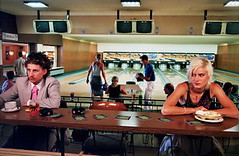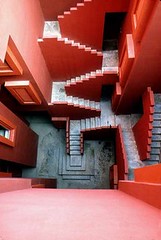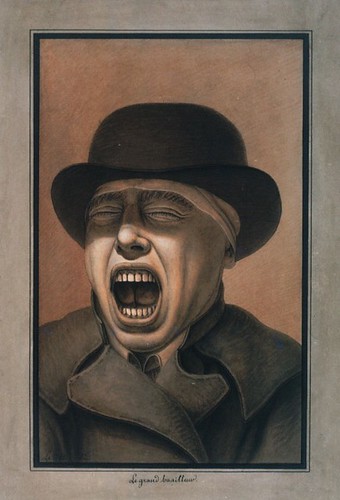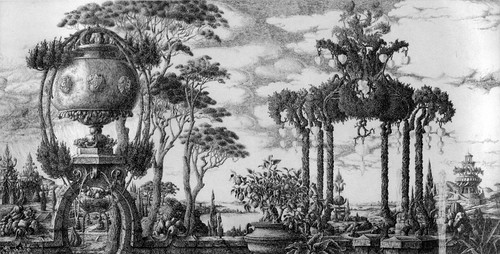I’ve posted about these two buildings before, but the similarities are to substantial to let it pass over not to post them juxtaposed. Find out more by clicking on the buildings.
Category Archives: architecture
The Borgesian fictions of Filip Dujardin
Filip Dujardin (born July 14 1971) is a Belgian photographer. He is currently (January 18 – March 31 2008) exhibiting at the Bozar (Paleis voor Schone Kunsten) of which the highlight is this photo, a sublime Borgesian fiction. Highly recommended.
World cinema classics #24
Steve + Sky (2004) – Felix van Groeningen
Steve+Sky (2004) is a Flemish film by director and screenwriter Felix van Groeningen (Dagen zonder lief). To the right of the screen capture is Titus De Voogdt, to the left the Delfine Bafort, the Belgian model/actress who recently starred in Looking for Alfred by Johan Grimonprez. The film was produced by Dirk Impens, best known for Daens, currently working on an adaptation of Dimitri Verhulst’s novel De Helaasheid der Dingen.
The film is situated in a Ghent “route nationale” red light district (locally and euphemistically known as “De Warme Landen”, literally the “warm countries”), and beautifully photographed by Ruben Impens who treats this Belgian vernacular architecture with a gloss of 1980s nostalgia.
The petty criminal Steve (Titus De Voogdt) is released from jail and looks up his ex cell mate Jean-Claude (Johan Heldenbergh) in the latter’s strip club. There he meets the intriguing Sky (Delfine Bafort). They start a passionate but impossible love affair in a story reminiscent of Betty Blue and the American production Buffalo ’66.
The soundtrack was compiled by Soulwax who chose “De meeste dromen zijn bedrog” by Marco Borsato, the cult hit “Putain Putain” by TC Matic, Reese‘s “To the Rock (to the Beat)” and “Beats of love” by Nacht und Nebel for the clubbish post-punk/New Beat atmosphere of the film.
The film editor is Nico Leunen, who learned the trade from Ludo Troch.
The film is noted for its naturalism with dialogues such as “A hole is a hole and a dick has no eyes.” (Jean-Claude) and a hilarious dispute between Jean-Claude and his pubescent daughter in which she asks him for money. When she gets the money he says: “Thank you, daddy!” and she replies “Thank you, asshole!”
Jan Sulmont at Kutsite.com has a fine review.
Previous “World Cinema Classics” and in the Wiki format here.
Viewing ‘wrong’ films for the right reasons
The image above is Xanadu in Calpe, Alicante (1969-1983), a surreal structure designed by Ricardo Bofill where the action of Jess Franco‘s 1980 Sade appropriation Eugenie, historia de una perversión is set. Robert Monell remarks that “this labyrinthine structure boggles the eye and teases our sense of perspective. This interior can be seen, shot from a radically different angle, in 1973’s The Perverse Countess.” Bofill’s design for the Catalan resort of Xanadu consists of a seven-story block with cubical living spaces arranged around a central utility core. Franco used this structure several times [1], [2].
Of all the “Euro trash” exploitation directors (I’m not counting Alain Robbe-Grillet, that’s artsploitation), Jess Franco had a knack for finding good interiors and exteriors. One of his films is set in Park Guell of Gaudi, but there are undoubtedly countless other examples to be found.
Of related interest is The Wrong House exhibition, on Hitchcock and architecture, currently showing in Antwerp.
Lequeu’s 250th anniversary
‘Le grand baailleur [sic],’ drawing by J-J Lequeu, from between
1777-1824 (Eng: the big yawner)
Jean-Jacques Lequeu (Rouen, September 14 1757 – 28 March 1826) was a French draughtsman and visionary architect. Today is his 250th anniversary.
Born in Rouen, he won a scholarship to go to Paris, but following the French revolution his architectural career never took off.
He spent time preparing the Architecture Civile, a book intended for publication, but which was never published. Most of his drawings can be found at the Bibliothèque nationale de France. Some of them are sexually explicit (Le Dieu Priape [1] (ca. 1779 – 1795) which shows a rather large male phallus and Trois images du sexe féminin) and are kept in the Enfer of the library. Most of these drawings have been reproduced in Duboy’s book but can also be found in Sade / Surreal.
Gaudi by Teshigahara
[Youtube=http://www.youtube.com/watch?v=tmchbfygroU]
Antoni Gaudí (1984) by Hiroshi Teshigahara
[Youtube=http://www.youtube.com/watch?v=NY3lr_7Lbh8]
Part two
I wonder who did the music. The music is by Tōru Takemitsu.
Modernism died 35 years ago today
Pruitt-Igoe, 1955
image sourced here.
Pruitt-Igoe, 1972
image sourced here.
On this day in 1972 modernist architecture died in St. Louis, Missouri at 3:32 pm when the Pruitt-Igoe buildings were dynamited. The first postmodern building had started construction one year earlier.
François Houtin’s imaginary gardens
Imaginary gardens with real toads in them
The French printmaker François Houtin (1950- ) is an artist whose work has been devoted almost exclusively to the depiction of imaginary gardens.
See www.spamula.net/blog/2007/02/houtin.html
Also an interesting blog: bibliodyssey.blogspot.com, introduced by Mr Aitch of Il Giornale as:
I’m grateful to Peacay, of Bibliodyssey renown, for introducing me to the work of this artist, nicely described by his friend and collaborator Gilbert Lascault as ‘the printmaker-gardener, the draughtsman-nurseryman, the demanding dreamer, the landscape artist, and the arboriculturalist-etcher.’
Here is another superb post from Bibliodyssey:
German naturalist Johann Christian Daniel von Schreber (1739-1810) trained as a physician and went and studied botany in Sweden under the great Carolus Linneaus. He would eventually edit one of Linneaus’s publications and he also included the Linnean binomial species naming system for the first time for some of the animals depicted above.
And this one on cabinets of curiosities is a must.
The juvenile delinquents — not the pop artists —
King Asa of Juda Destroying the Idols () – Monsù Desiderio
I was looking for info on Media Burn (1975) [Youtube] and [Youtube] and [Photo] by the Ant Farm collective and I happened upon Tyler Green’s Modern Art Notes blog. Daniel Flahiff introduces the top five American buildings blog-a-thon:
In response to Tyler Green’s challenge to choose your five favorite American buildings (okay, structures)–which is itself a response to the AIA list–here are my five [a list that could, of course, change tomorrow], in no particular order. What are yours? No, really, I want to know…
The reason I was searching for Media Burn in the first place was a previous search for American radical and activist Charles Radcliffe, the image of the Cadillac smashing into the wall of television turns up when you Google for Radcliffe.The reason I was looking for Radcliffe is that I wanted to introduce you to The Revolution of Modern Art and the Modern Art of Revolution, an essay published by the British arm of the Situationist International and co-authored by T. J. Clark, Christopher Gray, Charles Radcliffe and Donald Nicholson-Smith. This essay, which I’ve hosted for a while now (most if not all of the SI texts are copyleft), resurfaced to my consciousness following the comments by Muli Koppel to my recent post on social realism and anarchism in 19th century French art.
Of the essay the most potent quote is:
THE JUVENILE delinquents — not the pop artists — are the true inheritors of Dada. Instinctively grasping their exclusion from the whole of social life, they have denounced its products, ridiculed, degraded and destroyed them.
A smashed telephone, a burnt car, a terrorised cripple are the living denial of the ‘values’ in the name of which life is eliminated. Delinquent violence is a spontaneous overthrow of the abstract and contemplative role imposed on everyone, but the delinquents’ inability to grasp any possibility of really changing things once and for all forces them, like the Dadaists, to remain purely nihilistic.
They can neither understand nor find a coherent form for the direct participation in the reality they have discovered, for the intoxication and sense of purpose they feel, for the revolutionary values they embody. The Stockholm riots, the Hell’s Angels, the riots of Mods and Rockers — all are the assertion of the desire to play in a situation where it is totally impossible.
All reveal quite clearly the relationship between pure destructivity and the desire to play: the destruction of the game can only be avenged by destruction. Destructivity is the only passionate use to which one can put everything that remains irremediably separated. It is the only game the nihilist can play; the bloodbath of the 120 Days of Sodom proletarianised along with the rest.—The Revolution of Modern Art and the Modern Art of Revolution
Some info on Asa King of Judah of whom the destructions are pictured above:
Asa, King of Judah purged the land of pagan cults; all the sites of idolatrous worship were completely destroyed and the worshippers persecuted. The Queen Mother was also deposed for having been involved with same. There was also a large-scale crackdown on prostitutes.
Gustave Caillebotte (1848 – 1894)
The Impressionist and patron of other artists Gustave Caillebotte (1848 – 1894) painted the Boulevard Haussmann under many aspects of seasonal and daily change.
Gustave Caillebotte: Urban Impressionist (1995) – Anne Distel
[Amazon.com] [FR] [DE] [UK]
Book Description
Caillebotte’s vivid representations of Parisian life bridged the gap between Realism and Impressionism during the 1870s and early 1880s. His Paris Street: Rainy Day and Floorscrapers–each the subject of a fascinating, extensively illustrated analysis in this book–have become icons of the Impressionists’ devotion to scenes of modern urban life.
Prepared by an international team of scholars to accompany the major 1994-95 retrospective organized by the Réunion des Musées Nationaux/Musée d’Orsay, Paris, and The Art Institute of Chicago, Gustave Caillebotte: Urban Impressionist reproduces 89 of his paintings and 28 of his drawings and studies, many of them from little-known private collections. Thoughtful essays examine both his work and his crucial role as an early patron and promoter of Impressionism. A chronology, list of exhibitions, and selected bibliography provide additional invaluable information.
See also: French art – realism – impressionism – Arcades Project











